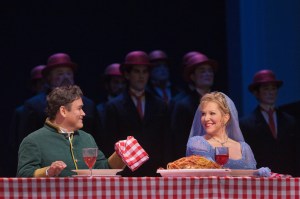
Photo: Ken Howard/Metropolitan Opera
Cooking is an inexact science: no matter how closely you follow the recipe, you can never be quite sure how the dish will turn out until it’s ready to serve. Whipping up a perfect soufflé, though, seems to be child’s play compared to producing Italian “bel canto” opera of the early 19th century—or so recent performances at the Met suggest. Starting with the raw materials of cast, conductor and production, Monday’s performance of La Cenerentola soared deliciously; Thursday’s I Puritani stuck to the pan.
Rossini’s 1817 Cenerentola is a lightly comic take on the Cinderella story, with a slight rearrangement of the characters—instead of a wicked stepmother, the heroine has a conniving deadbeat stepfather—and a plot devoid of magic. The alternate title of the work is “La bontà in trionfo,” the triumph of goodness, a phrase that precisely describes the performance of Joyce Didonato as Angelina, the Cinderella character. Her amber-hued mezzo exuded kindly warmth even in the part’s flashiest coloratura passages. Never betraying any sense of showing off vocally, she offered an impeccably musical expression of Angelina’s delicate, heartfelt emotion.
This was true even in the virtuoso finale aria “Non più mesta” (No longer unhappy) in which Angelina expresses her delight in a series of increasingly ornate variations on a fast, bouncy melody. Observing bel canto tradition, Ms. DiDonato added her own ornaments to Rossini’s score, but her immaculate turns and staccati never sounded gaudy or extravagant. Rather, they were simply and tastefully pretty, like delicate hand embroidery. Cenerentola often ends with the heroine morphing into a giddy prima donna, but Ms. DiDonato remained vocally in character, radiant with happiness at winning her prince.
It’s hard to imagine a more worthy reward for Angelina’s goodness than tenor Javier Camarena. Just weeks after his breakthrough performance in La Sonnambula, he jumped into this Cenerentola when the more celebrated tenor Juan Diego Flórez called in sick. Now Mr. Camarena has proved beyond a doubt he is one of the most thrilling tenors performing today. The roaring, stomping ovation that greeted his act two aria “Si, ritrovarla io giuro” was the unmistakable sound of a star being born.
What sets him apart from most other Rossini tenors is the size and richness of his voice, the sort of ringing lyric sound heard in artists who specialize in Puccini and Verdi. Mr. Camarena’s high C wouldn’t be out of place at the climax of “Di quella pira.” Yet he does not skimp on agility: the hundreds of scales and roulades festooning the vocal line sounded clear and shapely. While he’s not the most specific actor in the world, he invariably projects a joy in singing that’s as rare on the opera stage as the rock-solid high D with which he capped his big solo.
Also a pleasant surprise was the debut of Italian baritone Pietro Spagnoli as the prince’s witty servant Dandini. He’s got a solid voice and—unusually in this comic part—the vocal flexibility to cope with the coloratura passages of the character’s flashy entrance aria. Equally refreshing was his willingness to underplay the comedy, so that the character’s disguise as the prince was, for once, perfectly believable.
Less satisfying was bass-baritone Luca Pisaroni as the philosopher Alidoro, the “fairy godfather” of the story. His Italian diction was precise and expressive, but I missed a richer, more exuberant tone in his long bravura aria “La, del ciel nell’arcano profondo.” Baritone Alessandro Corbelli, who’s been singing in the Met’s Cenerentola since the opera premiered here in 1997, repeated his broadly comic interpretation of Don Magnifico, Angelina’s stepfather. The voice, still true, is now a little on the dry side for a role that includes three full-length arias.
Rachelle Durkin and Patricia Risley sounded fresh and vivid as the stepsisters, but their relentless mugging and comic shtick belonged in an outtake reel of RuPaul’s Drag Race. This unfunny excess was not all their fault, because Cesare Lievi’s mildly surrealistic production is elbow-deep in sight gags, up to and including a spaghetti-flinging food fight to bring down the first act curtain.
Cenerentola trumped Puritani in every category except one: conducting. While Fabio Luisi’s leadership of the Rossini boasted a precise, unsmiling brilliance, Michele Mariotti found precisely the hushed, elegiac tone for Bellini’s melodrama. Just seconds into the prelude, the Met orchestra’s muted horns evoked not just a fanfare heard from far away, but a dim memory of a fanfare.
But the cast, on paper equal to that for the Rossini, didn’t quite deliver. Olga Peretyatko, in her Met debut, revealed an attractive light soprano as the mad Puritan maiden Elvira, recalling the coloratura sopranos of the early 20th century. Though she sang with precision and perfect taste, the effect was more scrupulous than emotionally overpowering.
Tenor Lawrence Brownlee, as her lover Arturo, took his high-lying entrance aria “A te, o cara” at an impressively stately pace, showing superb breath control. Later, he took—just barely—an all-but-impossible written high F in the final scene. Despite the lovely soft-grained warmth of his voice and pristine technique, though, his performance felt more like a master class in singing than a musical drama.
More assured was the veteran bass Michele Pertusi, whose graceful phrasing made his solo “Cinta di fiori” the evening’s only moment of true bel canto, singing that was both beautiful and expressive. The debuting baritone Maksim Aniskin, tasked with replacing Met favorite Mariusz Kwiecie on short notice, made no particular impression, but the curtain went up on schedule.
The late Sandro Sequi’s mounting of this opera, deliberately old-fashioned when it opened in 1976, now hardly rises to the level of low camp. About the only time anyone snaps out of stiff tableau formation is when a gaggle of Puritan women—on their way home from church!—break into a lively polka.
No, you can’t expect every night at the Met to be a gourmet feast, but this lazily produced Puritani was downright inedible.

